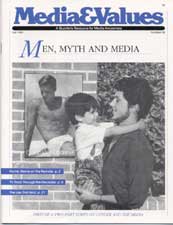PASTORING: What Gender is God?
|
This article originally appeared in Issue# 48
|
Exploring male images in media uncovers deeper questions about the nature of divinity and who can image God/the divine.
Recently, my local newspaper ran a review of a comedian's live show that focused on his male bravado and his rather brutal putdown of women. The reviewer noted that the audience, mostly young and male, enjoyed the jokes about sex-without-commitment and the attitude that women were there to be used.
I recalled this review while reading Mark Miller's essay on TV fathers in this issue. There was a thread of painful familiarity in his account of the continuing dominance of male power even if the external trappings had changed. While recognition of male power is important in analyzing media images, it is also essential to explore how and why these images are created and reinforced in our consciousness.
Male domination and female subordination are images tightly woven into Western cultures, both religious (Jewish, Christian and Muslim) and secular (Greek, Roman and Enlightenment). The re-thinking of male and female must begin with these roots, with our religious and philosophical traditions that underlie "how the world works." For even as women have gained greater power in many religious organizations, the fundamental image of God/the divine as male has not changed.
Despite the acceptance of ordination for women (in some traditions), this change should not be mistaken for the real revolution that still must cake place at a deeper level; the fundamental acceptance of females as equal to males in the very nature of humankind a nature established and blessed by God/the divine.
Exploring male dominance challenges religious educators and leaders to ask tough questions. These questions become difficult and upsetting as they go to the very nature of divinity and how it is reflected in social and political relations. We may start out asking questions about male images in the media or in society at large but in the religious community we have some deeper work to do:
- What does it mean to call God "father?" Why is it unsettling to call God "mother?"
- What is the implicit message in praying for "mankind?"
- What is the continued impact of hymns or prayers that focus on male images of leadership and divinity?
- How does the image of God as male reinforce and perpetuate the dominance of males and the subordination of females in everyday personal relationships and the very structures of society?
Encouraging a congregation or study group to grapple with these issues is urgent if we are serious about eradicating sexism in our society today. A valuable exercise is to ask people the impact of calling God "white father" and praying for blessings upon "white men." These expressions may sound absurd, but they also help us understand in a more jarring fashion how the words, prayers and images we use in religious settings create a world where if God is male, then no wonder the male is god.



